中国人民健康保险股份有限公司关爱专家短期重疾(推荐版)团体疾病保险(0)
- 格式:pdf
- 大小:188.86 KB
- 文档页数:17
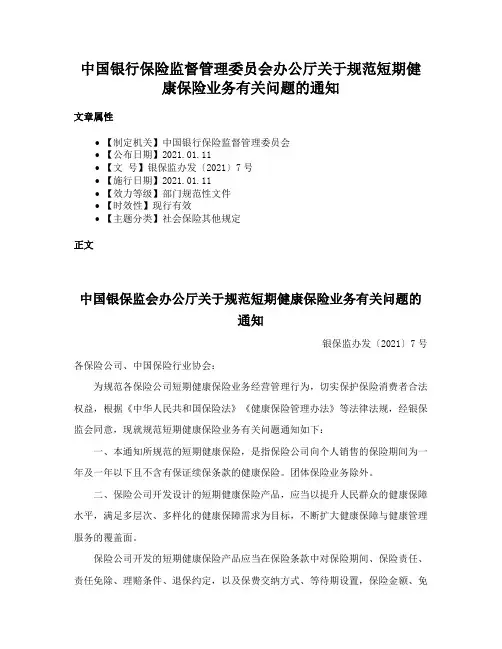
中国银行保险监督管理委员会办公厅关于规范短期健康保险业务有关问题的通知文章属性•【制定机关】中国银行保险监督管理委员会•【公布日期】2021.01.11•【文号】银保监办发〔2021〕7号•【施行日期】2021.01.11•【效力等级】部门规范性文件•【时效性】现行有效•【主题分类】社会保险其他规定正文中国银保监会办公厅关于规范短期健康保险业务有关问题的通知银保监办发〔2021〕7号各保险公司、中国保险行业协会:为规范各保险公司短期健康保险业务经营管理行为,切实保护保险消费者合法权益,根据《中华人民共和国保险法》《健康保险管理办法》等法律法规,经银保监会同意,现就规范短期健康保险业务有关问题通知如下:一、本通知所规范的短期健康保险,是指保险公司向个人销售的保险期间为一年及一年以下且不含有保证续保条款的健康保险。
团体保险业务除外。
二、保险公司开发设计的短期健康保险产品,应当以提升人民群众的健康保障水平,满足多层次、多样化的健康保障需求为目标,不断扩大健康保障与健康管理服务的覆盖面。
保险公司开发的短期健康保险产品应当在保险条款中对保险期间、保险责任、责任免除、理赔条件、退保约定,以及保费交纳方式、等待期设置,保险金额、免赔额、赔付比例等产品关键信息进行清晰、明确、无歧义的表述。
三、保险公司开发的短期健康保险产品中包含续保责任的,应当在保险条款中明确表述为“不保证续保”条款。
不保证续保条款中至少应当包含以下内容:本产品保险期间为一年(或不超过一年)。
保险期间届满,投保人需要重新向保险公司申请投保本产品,并经保险人同意,交纳保险费,获得新的保险合同。
保险公司不得在短期健康保险产品条款、宣传材料中使用“自动续保”“承诺续保”“终身限额”等易与长期健康保险混淆的词句。
四、保险公司应当科学合理确定短期健康保险产品价格。
产品定价所使用的各项精算假设应当以经验数据为基础,不得随意约定或与经营实际出现较大偏差。
保险公司可以根据不同风险因素确定差异化的产品费率,并严格按照审批或者备案的产品费率销售短期个人健康保险产品。
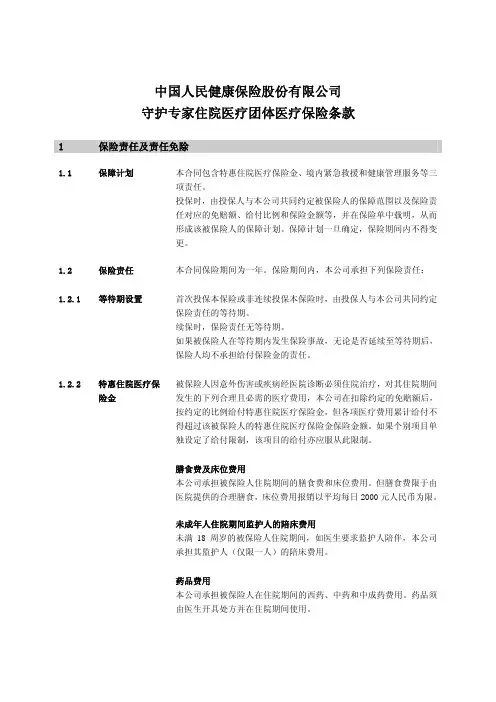
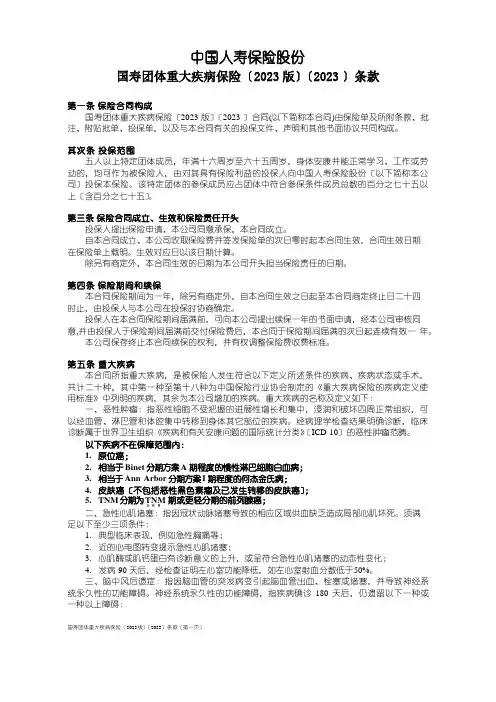
中国人寿保险股份国寿团体重大疾病保险〔2023版〕〔2023〕条款第一条保险合同构成国寿团体重大疾病保险〔2023版〕〔2023〕合同(以下简称本合同)由保险单及所附条款、批注、附贴批单、投保单,以及与本合同有关的投保文件、声明和其他书面协议共同构成。
其次条投保范围五人以上特定团体成员,年满十六周岁至六十五周岁,身体安康并能正常学习、工作或劳动的,均可作为被保险人,由对其具有保险利益的投保人向中国人寿保险股份〔以下简称本公司〕投保本保险。
该特定团体的参保成员应占团体中符合参保条件成员总数的百分之七十五以上〔含百分之七十五〕。
第三条保险合同成立、生效和保险责任开头投保人提出保险申请、本公司同意承保,本合同成立。
自本合同成立、本公司收取保险费并签发保险单的次日零时起本合同生效,合同生效日期在保险单上载明。
生效对应日以该日期计算。
除另有商定外,本合同生效的日期为本公司开头担当保险责任的日期。
第四条保险期间和续保本合同保险期间为一年,除另有商定外,自本合同生效之日起至本合同商定终止日二十四时止,由投保人与本公司在投保时协商确定。
投保人在本合同保险期间届满前,可向本公司提出续保一年的书面申请,经本公司审核同意,并由投保人于保险期间届满前交付保险费后,本合同于保险期间届满的次日起连续有效一年。
本公司保存终止本合同续保的权利,并有权调整保险费收费标准。
第五条重大疾病本合同所指重大疾病,是被保险人发生符合以下定义所述条件的疾病、疾病状态或手术,共计二十种,其中第一种至第十八种为中国保险行业协会制定的《重大疾病保险的疾病定义使用标准》中列明的疾病,其余为本公司增加的疾病。
重大疾病的名称及定义如下:一、恶性肿瘤:指恶性细胞不受把握的进展性增长和集中,浸润和破坏四周正常组织,可以经血管、淋巴管和体腔集中转移到身体其它部位的疾病。
经病理学检查结果明确诊断,临床诊断属于世界卫生组织《疾病和有关安康问题的国际统计分类》〔ICD-10〕的恶性肿瘤范畴。
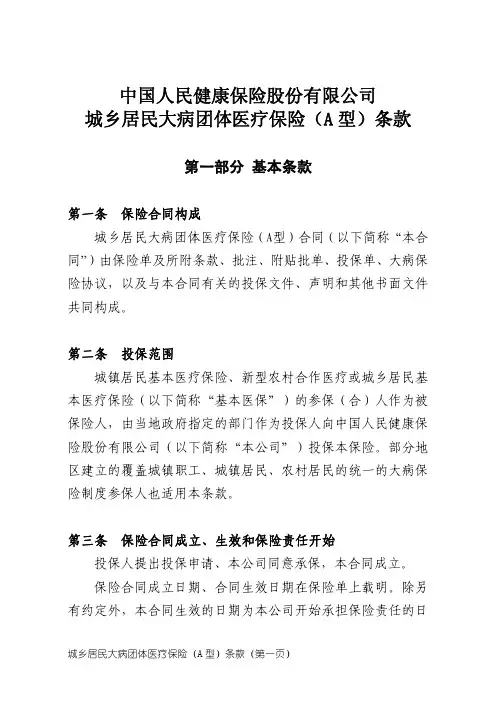
中国人民健康保险股份有限公司城乡居民大病团体医疗保险(A型)条款第一部分 基本条款第一条 保险合同构成城乡居民大病团体医疗保险(A型)合同(以下简称“本合同”)由保险单及所附条款、批注、附贴批单、投保单、大病保险协议,以及与本合同有关的投保文件、声明和其他书面文件共同构成。
第二条 投保范围城镇居民基本医疗保险、新型农村合作医疗或城乡居民基本医疗保险(以下简称“基本医保”)的参保(合)人作为被保险人,由当地政府指定的部门作为投保人向中国人民健康保险股份有限公司(以下简称“本公司”)投保本保险。
部分地区建立的覆盖城镇职工、城镇居民、农村居民的统一的大病保险制度参保人也适用本条款。
第三条 保险合同成立、生效和保险责任开始投保人提出投保申请、本公司同意承保,本合同成立。
保险合同成立日期、合同生效日期在保险单上载明。
除另有约定外,本合同生效的日期为本公司开始承担保险责任的日期。
第四条 保险期间本合同的保险期间为一年,可根据大病保险协议约定的合作期限办理续保。
每一保险年度的保险责任起止日期与基本医保责任起止日期一致。
第五条 保险责任在本合同保险期间内,被保险人在当地基本医保定点医疗机构诊疗或者经当地基本医保主管部门批准后转至其他有资质的医疗机构诊疗,本公司对其实际发生并支出的、符合当地基本医保规定的或本公司与当地基本医保主管部门协商后认可的合规医疗费用,可依下列约定承担保险责任:一、住院医疗保险责任对被保险人在本合同保险期间内实际发生并支出的合规住院医疗费用中经当地基本医保支付或补偿后的剩余部分,本公司扣除住院起付金额后,按本合同约定的住院给付比例给付保险金,但对每一被保险人给付的保险金以本合同约定的该被保险人的住院医疗保险金额为限,一次或累计给付的保险金达到该被保险人的住院医疗保险金额时,本合同对该被保险人的住院保险责任终止。
住院起付金额、给付比例及合规医疗费用给付范围由投保人与本公司协商确定并在保险单上载明。
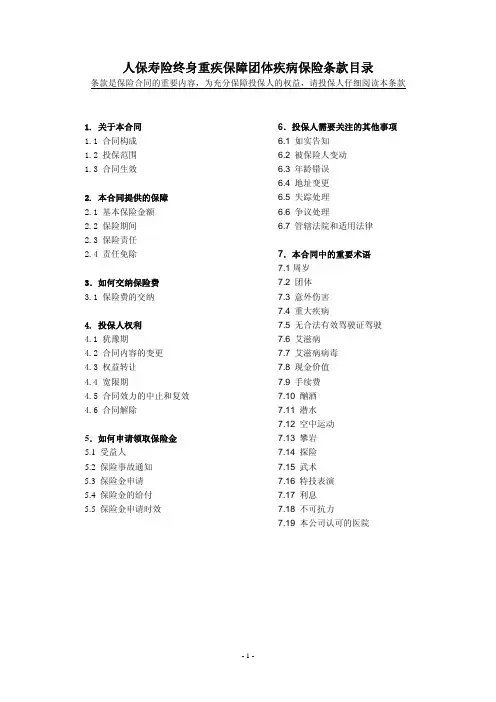
人保寿险终身重疾保障团体疾病保险条款目录条款是保险合同的重要内容,为充分保障投保人的权益,请投保人仔细阅读本条款1. 关于本合同 6.投保人需要关注的其他事项1.1 合同构成 6.1 如实告知1.2 投保范围 6.2 被保险人变动1.3 合同生效 6.3 年龄错误6.4 地址变更2. 本合同提供的保障 6.5 失踪处理2.1 基本保险金额 6.6 争议处理2.2 保险期间 6.7 管辖法院和适用法律2.3 保险责任2.4 责任免除 7.本合同中的重要术语7.1周岁3.如何交纳保险费 7.2 团体3.1 保险费的交纳 7.3 意外伤害7.4 重大疾病4. 投保人权利7.5 无合法有效驾驶证驾驶4.1 犹豫期7.6 艾滋病4.2 合同内容的变更 7.7 艾滋病病毒4.3 权益转让 7.8 现金价值4.4 宽限期 7.9 手续费4.5 合同效力的中止和复效 7.10 酗酒4.6 合同解除 7.11 潜水7.12 空中运动5.如何申请领取保险金7.13 攀岩5.1 受益人 7.14 探险5.2 保险事故通知 7.15 武术5.3 保险金申请 7.16 特技表演5.4 保险金的给付 7.17 利息5.5 保险金申请时效 7.18 不可抗力7.19 本公司认可的医院人保寿险终身重疾保障团体疾病保险条款在本条款中,“本公司”指中国人保寿险有限公司。
1 关于本合同1.1 合同构成 人保寿险终身重疾保障团体疾病保险合同(以下简称“本合同”)由保险条款、保险单或其他保险凭证、所附的投保单及相关文件、有关的声明、批注单及其他约定书构成。
1.2 投保范围 凡十六周岁(见7.1)以上(含十六周岁)六十五周岁以下(含六十五周岁),身体健康能够正常工作的团体(见7.2)在职人员,或其他本公司认可的成员,可作为被保险人参加本保险。
机关、企业、事业单位和社会团体可作为投保人为本单位符合参保条件的人员向本公司投保本保险。
单位投保时,其投保人数不应低于五人,而且本单位符合投保条件的人员必须百分之七十五以上投保。
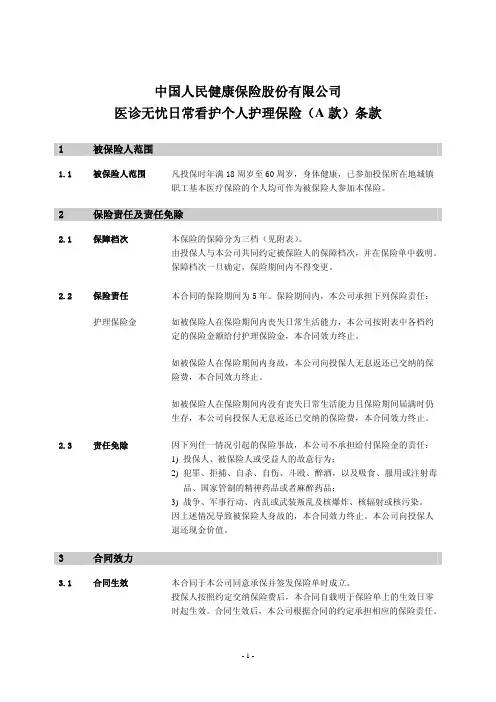
中国人民健康保险股份有限公司医诊无忧日常看护个人护理保险(A款)条款1 被保险人范围1.1 被保险人范围凡投保时年满18周岁至60周岁,身体健康,已参加投保所在地城镇职工基本医疗保险的个人均可作为被保险人参加本保险。
2 保险责任及责任免除2.1 保障档次本保险的保障分为三档(见附表)。
由投保人与本公司共同约定被保险人的保障档次,并在保险单中载明。
保障档次一旦确定,保险期间内不得变更。
2.2 保险责任本合同的保险期间为5年。
保险期间内,本公司承担下列保险责任:护理保险金如被保险人在保险期间内丧失日常生活能力,本公司按附表中各档约定的保险金额给付护理保险金,本合同效力终止。
如被保险人在保险期间内身故,本公司向投保人无息返还已交纳的保险费,本合同效力终止。
如被保险人在保险期间内没有丧失日常生活能力且保险期间届满时仍生存,本公司向投保人无息返还已交纳的保险费,本合同效力终止。
2.3 责任免除因下列任一情况引起的保险事故,本公司不承担给付保险金的责任:1) 投保人、被保险人或受益人的故意行为;2) 犯罪、拒捕、自杀、自伤、斗殴、醉酒,以及吸食、服用或注射毒品、国家管制的精神药品或者麻醉药品;3) 战争、军事行动、内乱或武装叛乱及核爆炸、核辐射或核污染。
因上述情况导致被保险人身故的,本合同效力终止。
本公司向投保人退还现金价值。
3 合同效力3.1 合同生效 本合同于本公司同意承保并签发保险单时成立。
投保人按照约定交纳保险费后,本合同自载明于保险单上的生效日零时起生效。
合同生效后,本公司根据合同的约定承担相应的保险责任。
3.2 犹豫期 自投保人签收保险单之日起有10天的犹豫期。
如果投保人在此期间内向本公司书面申请撤销合同,本合同不产生效力,本公司将不承担任何保险责任。
投保人犹豫期内撤销合同,本公司将无息退还投保人所交的保险费。
3.3 合同解除 保险期间内,如被保险人未发生本合同以及附加险合同责任范围内的保险事故,投保人可以书面申请解除本合同。
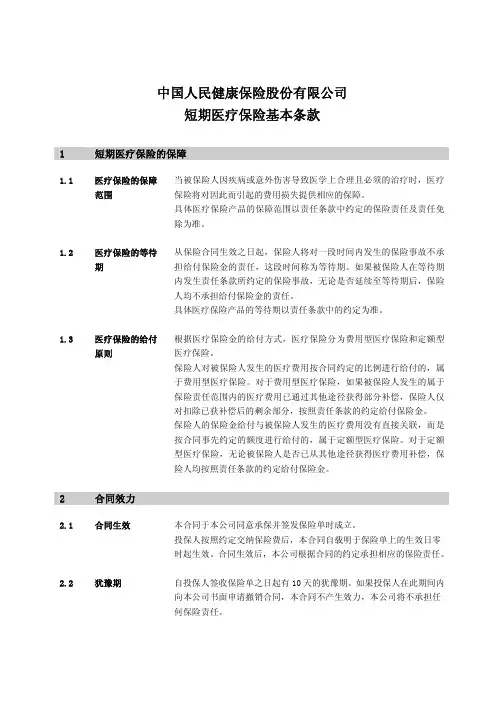
中国人民健康保险股份有限公司短期医疗保险基本条款1 短期医疗保险的保障1.1 医疗保险的保障范围 当被保险人因疾病或意外伤害导致医学上合理且必须的治疗时,医疗保险将对因此而引起的费用损失提供相应的保障。
具体医疗保险产品的保障范围以责任条款中约定的保险责任及责任免除为准。
1.2 医疗保险的等待期 从保险合同生效之日起,保险人将对一段时间内发生的保险事故不承担给付保险金的责任,这段时间称为等待期。
如果被保险人在等待期内发生责任条款所约定的保险事故,无论是否延续至等待期后,保险人均不承担给付保险金的责任。
具体医疗保险产品的等待期以责任条款中的约定为准。
1.3 医疗保险的给付原则 根据医疗保险金的给付方式,医疗保险分为费用型医疗保险和定额型医疗保险。
保险人对被保险人发生的医疗费用按合同约定的比例进行给付的,属于费用型医疗保险。
对于费用型医疗保险,如果被保险人发生的属于保险责任范围内的医疗费用已通过其他途径获得部分补偿,保险人仅对扣除已获补偿后的剩余部分,按照责任条款的约定给付保险金。
保险人的保险金给付与被保险人发生的医疗费用没有直接关联,而是按合同事先约定的额度进行给付的,属于定额型医疗保险。
对于定额型医疗保险,无论被保险人是否已从其他途径获得医疗费用补偿,保险人均按照责任条款的约定给付保险金。
2 合同效力2.1 合同生效 本合同于本公司同意承保并签发保险单时成立。
投保人按照约定交纳保险费后,本合同自载明于保险单上的生效日零时起生效。
合同生效后,本公司根据合同的约定承担相应的保险责任。
2.2 犹豫期 自投保人签收保险单之日起有10天的犹豫期。
如果投保人在此期间内向本公司书面申请撤销合同,本合同不产生效力,本公司将不承担任何保险责任。
投保人犹豫期内撤销合同,本公司将无息退还投保人所交的全部保险费。
2.3 保险期间 本合同的有效期间以保险单中载明的期间为准。
2.4 合同解除 保险期间内,如果被保险人未发生本合同责任范围内的保险事故,投保人可以书面申请解除本合同。
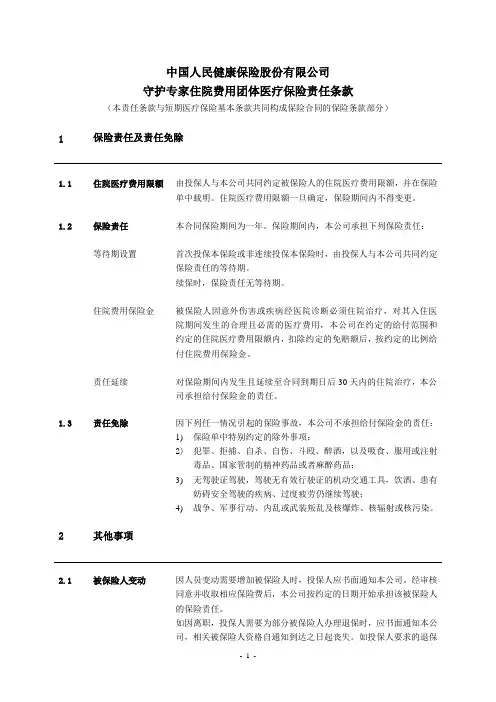
中国人民健康保险股份有限公司守护专家住院费用团体医疗保险责任条款(本责任条款与短期医疗保险基本条款共同构成保险合同的保险条款部分)保险责任及责任免除11.1 住院医疗费用限额由投保人与本公司共同约定被保险人的住院医疗费用限额,并在保险单中载明。
住院医疗费用限额一旦确定,保险期间内不得变更。
1.2 保险责任本合同保险期间为一年。
保险期间内,本公司承担下列保险责任:等待期设置首次投保本保险或非连续投保本保险时,由投保人与本公司共同约定保险责任的等待期。
续保时,保险责任无等待期。
住院费用保险金被保险人因意外伤害或疾病经医院诊断必须住院治疗,对其入住医院期间发生的合理且必需的医疗费用,本公司在约定的给付范围和约定的住院医疗费用限额内,扣除约定的免赔额后,按约定的比例给付住院费用保险金。
责任延续对保险期间内发生且延续至合同到期日后30天内的住院治疗,本公司承担给付保险金的责任。
1.3 责任免除因下列任一情况引起的保险事故,本公司不承担给付保险金的责任:1)保险单中特别约定的除外事项;2)犯罪、拒捕、自杀、自伤、斗殴、醉酒,以及吸食、服用或注射毒品、国家管制的精神药品或者麻醉药品;3)无驾驶证驾驶,驾驶无有效行驶证的机动交通工具,饮酒、患有妨碍安全驾驶的疾病、过度疲劳仍继续驾驶;4)战争、军事行动、内乱或武装叛乱及核爆炸、核辐射或核污染。
2 其他事项2.1被保险人变动因人员变动需要增加被保险人时,投保人应书面通知本公司。
经审核同意并收取相应保险费后,本公司按约定的日期开始承担该被保险人的保险责任。
如因离职,投保人需要为部分被保险人办理退保时,应书面通知本公司,相关被保险人资格自通知到达之日起丧失。
如投保人要求的退保失,本公司在扣除手续费后退还相关被保险人的未满期净保费。
如果被保险人已发生本合同责任范围内的保险事故,投保人不得为其办理退保。
本合同的被保险人总数小于八人,或低于有参加保险资格人数的百分之七十五时,本公司有权解除本合同,并在扣除手续费后退还未满期净保费。
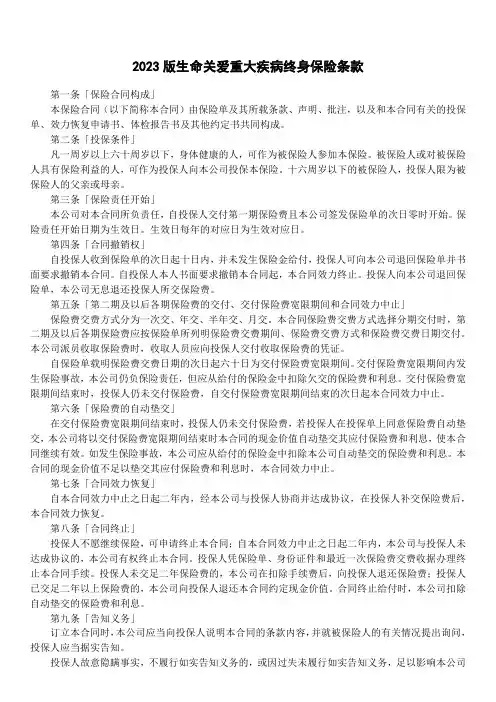
2023版生命关爱重大疾病终身保险条款第一条「保险合同构成」本保险合同(以下简称本合同)由保险单及其所载条款、声明、批注,以及和本合同有关的投保单、效力恢复申请书、体检报告书及其他约定书共同构成。
第二条「投保条件」凡一周岁以上六十周岁以下,身体健康的人,可作为被保险人参加本保险。
被保险人或对被保险人具有保险利益的人,可作为投保人向本公司投保本保险。
十六周岁以下的被保险人,投保人限为被保险人的父亲或母亲。
第三条「保险责任开始」本公司对本合同所负责任,自投保人交付第一期保险费且本公司签发保险单的次日零时开始。
保险责任开始日期为生效日。
生效日每年的对应日为生效对应日。
第四条「合同撤销权」自投保人收到保险单的次日起十日内,并未发生保险金给付,投保人可向本公司退回保险单并书面要求撤销本合同。
自投保人本人书面要求撤销本合同起,本合同效力终止。
投保人向本公司退回保险单,本公司无息退还投保人所交保险费。
第五条「第二期及以后各期保险费的交付、交付保险费宽限期间和合同效力中止」保险费交费方式分为一次交、年交、半年交、月交。
本合同保险费交费方式选择分期交付时,第二期及以后各期保险费应按保险单所列明保险费交费期间、保险费交费方式和保险费交费日期交付。
本公司派员收取保险费时,收取人员应向投保人交付收取保险费的凭证。
自保险单载明保险费交费日期的次日起六十日为交付保险费宽限期间。
交付保险费宽限期间内发生保险事故,本公司仍负保险责任,但应从给付的保险金中扣除欠交的保险费和利息。
交付保险费宽限期间结束时,投保人仍未交付保险费,自交付保险费宽限期间结束的次日起本合同效力中止。
第六条「保险费的自动垫交」在交付保险费宽限期间结束时,投保人仍未交付保险费,若投保人在投保单上同意保险费自动垫交,本公司将以交付保险费宽限期间结束时本合同的现金价值自动垫交其应付保险费和利息,使本合同继续有效。
如发生保险事故,本公司应从给付的保险金中扣除本公司自动垫交的保险费和利息。
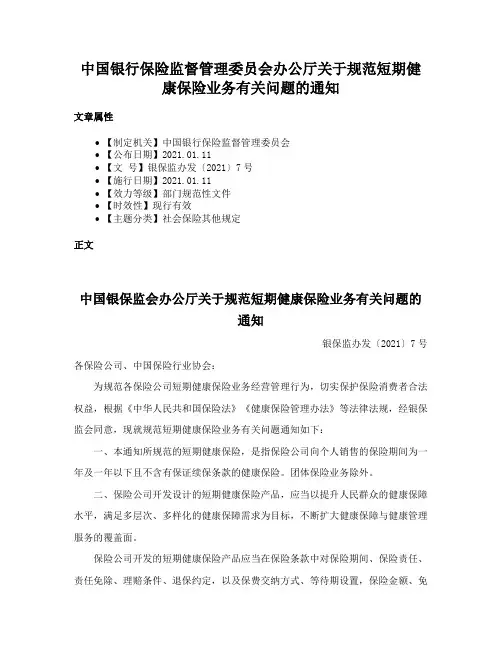
中国银行保险监督管理委员会办公厅关于规范短期健康保险业务有关问题的通知文章属性•【制定机关】中国银行保险监督管理委员会•【公布日期】2021.01.11•【文号】银保监办发〔2021〕7号•【施行日期】2021.01.11•【效力等级】部门规范性文件•【时效性】现行有效•【主题分类】社会保险其他规定正文中国银保监会办公厅关于规范短期健康保险业务有关问题的通知银保监办发〔2021〕7号各保险公司、中国保险行业协会:为规范各保险公司短期健康保险业务经营管理行为,切实保护保险消费者合法权益,根据《中华人民共和国保险法》《健康保险管理办法》等法律法规,经银保监会同意,现就规范短期健康保险业务有关问题通知如下:一、本通知所规范的短期健康保险,是指保险公司向个人销售的保险期间为一年及一年以下且不含有保证续保条款的健康保险。
团体保险业务除外。
二、保险公司开发设计的短期健康保险产品,应当以提升人民群众的健康保障水平,满足多层次、多样化的健康保障需求为目标,不断扩大健康保障与健康管理服务的覆盖面。
保险公司开发的短期健康保险产品应当在保险条款中对保险期间、保险责任、责任免除、理赔条件、退保约定,以及保费交纳方式、等待期设置,保险金额、免赔额、赔付比例等产品关键信息进行清晰、明确、无歧义的表述。
三、保险公司开发的短期健康保险产品中包含续保责任的,应当在保险条款中明确表述为“不保证续保”条款。
不保证续保条款中至少应当包含以下内容:本产品保险期间为一年(或不超过一年)。
保险期间届满,投保人需要重新向保险公司申请投保本产品,并经保险人同意,交纳保险费,获得新的保险合同。
保险公司不得在短期健康保险产品条款、宣传材料中使用“自动续保”“承诺续保”“终身限额”等易与长期健康保险混淆的词句。
四、保险公司应当科学合理确定短期健康保险产品价格。
产品定价所使用的各项精算假设应当以经验数据为基础,不得随意约定或与经营实际出现较大偏差。
保险公司可以根据不同风险因素确定差异化的产品费率,并严格按照审批或者备案的产品费率销售短期个人健康保险产品。
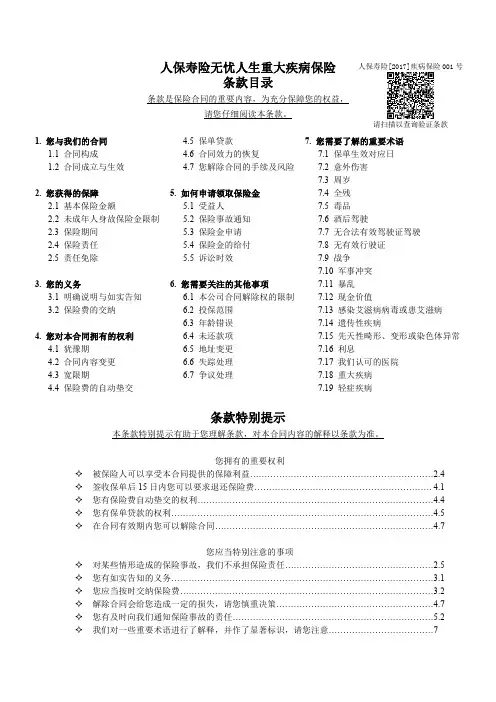
中国人寿保险股份有限公司国寿女性安康团体疾病保险(A款)条款第一条保险合同构成国寿女性安康团体疾病保险(A款)合同(以下简称本合同)由保险单及所附条款、批注、附贴批单、投保单、以及与本合同有关的投保文件、声明和其他书面协议共同构成。
第二条投保范围凡年龄在十六周岁至六十周岁,身体健康,能正常工作或者劳动的女性在职人员,均可作为被保险人,由其所在单位作为投保人向中国人寿保险股份有限公司(以下简称本公司)投保本保险,符合投保条件的在职人员必须百分之七十五以上投保,且符合投保条件的人数不低于五人。
第三条保险合同成立、生效和保险责任开始投保人提出保险申请、本公司同意承保,本合同成立。
自本合同成立、本公司收取保险费并签发保险单的次日零时起本合同生效,合同生效日期在保险单上载明。
除另有约定外,本合同生效的日期为本公司开始承担保险责任的日期。
第四条保险期间本合同的保险期间最长为一年,除另有约定外,自本合同生效之日起至约定终止日二十四时止,由投保人在投保时与本公司协商确定。
第五条保险责任在本合同保险期间内,本公司依下列约定承担保险责任:一、被保险人自本合同生效之日起九十日后(按本合同约定连续投保不受九十日规定的限制),初次发生并经二级以上(含二级)医院确诊患原发性卵巢癌、原发性子宫内膜癌、原发性宫颈癌、原发性输卵管癌、原发性阴道癌和子宫肉瘤六种疾病中的任何一种或者多种,本公司按本合同约定的保险金额给付保险金,除本条第三款约定的保险责任外,本合同对该被保险人的保险责任终止。
本公司承担的该项保险责任以本合同约定的保险金额为限。
二、被保险人自本合同生效之日起九十日后(按本合同约定连续投保不受九十日规定的限制),初次发生并经二级以上(含二级)医院确诊患原发性乳腺癌,本公司按本合同约定的保险金额的二倍给付保险金,除本条第三款约定的保险责任外,本合同对该被保险人的保险责任终止。
三、被保险人自本合同生效之日起九十日后(按本合同约定连续投保不受九十日规定的限制),在二级以上(含二级)医院进行子宫全切术或卵巢切除术,本公司分别按本合同约定的保险金额的10%给付保险金,本合同对该被保险人的该项保险责任终止。
中国人民保险集团股份有限公司,简称中国人保或人民保险,英文标志PICC,属于中国央企。
旗下拥有拥有人保寿险、人保健康、人保财险、人保资产、人保投资等多家保险子公司,其中,最为大家所熟识的当属人保寿险、人保健康和人保财险。
接下来,我们看一下他们的基本信息:中国人民保险集团股份有限公司不仅是世界五百强之一,而且是世界上最大的保险公司之一,实力不用多说,完全符合大众心中关于大公司的定义。
接下来,我就为大家具体介绍人保寿险、人保财险理赔、服务怎么样?产品值得买吗?一、人保寿险和人保财险的理赔、服务怎么样?我们老百姓买保险,最关心的永远都是:你的理赔靠谱吗?你的服务怎么样?1、理赔靠谱吗?我整理了56家保险公司2019年的理赔数据,人保寿险全年理赔总数是70亿,平均理赔申请时效2.17天。
其实从数据可以看到,无论是大公司还是小公司,各家公司理赔速度都不慢,绝大部分人都可以获得理赔。
这也印证了我一直以来的观点:保险赔不赔,只会由合同条款决定,而不是品牌。
2、服务怎么样?我们老百姓买保险,最关心的永远是你的理赔服务怎么样。
什么样的服务才叫好?有人觉得代理人的服务态度要好,也有人觉得理赔快就够了,还有人会看重客服电话接通速度这种细节,总之每个人的想法都不一样。
为了让大家有一个统一的标准,银保信根据过往大量的数据和经验,按照以下8个指标,对服务进行评级:除此之外,保单送达时效、业务办理的速度、电话接通率等,也会影响服务体验,因此都纳入到评级。
如果保险公司有重要的服务创新,或者重大的负面事件,也会对评级有一定的影响。
最后将每项得分相加,根据分数分为10级,其中最高为AAA级,最低为D级。
最终排名结果如下:AAA级暂无;人保财险被评为第1的AA级别,表现非常不错。
二、人保哪款产品最值得买?最近,人保健康响应国家号召,推出了行业首款能保一辈子的医疗险-好医保终身防癌医疗险”,以前的医疗险只能保障1年或者6年保证续保,这款终身续保的产品的标志着我国医疗险的进步!接下来,我们就详细的分析这款产品。
中国人民健康保险股份有限公司短期疾病保险基本条款1 短期疾病保险的保障1.1 疾病保险的保障范围 当被保险人发生某种疾病时,疾病保险将为其提供相应的保障。
具体疾病保险产品的保障范围以责任条款中约定的保险责任及责任免除为准。
2 合同效力2.1 合同生效 本合同于本公司同意承保并签发保险单时成立。
投保人按照约定交纳保险费后,本合同自载明于保险单上的生效日零时起生效。
合同生效后,本公司根据合同的约定承担相应的保险责任。
2.2 犹豫期 自投保人签收保险单之日起有10天的犹豫期。
如果投保人在此期间内向本公司书面申请撤销合同,本合同不产生效力,本公司将不承担任何保险责任。
投保人犹豫期内撤销合同,本公司将无息退还投保人所交的全部保险费。
2.3 保险期间 本合同的有效期间以保险单中载明的期间为准。
2.4 合同解除 保险期间内,如果被保险人未发生本合同责任范围内的保险事故,投保人可以书面申请解除本合同。
自本公司接到申请书之日起,本合同效力终止。
本公司在收到申请书30天内,扣除手续费后退还未满期净保费。
如果被保险人已发生本合同责任范围内的保险事故,本公司将不接受合同解除申请。
3 保险费3.1 保险费 保险费将根据投保人与本公司约定的保障内容及被保险人的年龄、性别和风险状况进行确定,投保人应一次性向本公司缴清保险费。
4 保险金的申请及给付4.1 保险事故通知 投保人或被保险人应在知道保险事故发生之日起10天内通知本公司,否则,应承担由于通知延迟而导致本公司增加的调查、检验等费用;因未及时通知而导致保险事故的性质、原因、损失程度等无法确认的,对无法认定的全部或部分责任,本公司不承担保险金的给付责任,但因不可抗力导致的延迟除外。
4.2 受益人 疾病保险的身故保险金受益人由被保险人进行指定或变更;如果被保险人书面同意,投保人亦可指定或变更身故保险金受益人。
除合同另有约定外,疾病保险的其他保险金受益人为被保险人本人。
4.3 保险金的申请 申请保险金时,由申请人按照责任条款的要求提交必需的证明和资料。
PICC Health Insurance Co. Ltd.Care Expert - Group Short-term Critical Illness Insurance(Recommended Version)(These conditions and the general conditions of Short-term Illness Insurance constitute the insurance conditions of the insurance contract.) Code:2603011 Liabilities and Exclusions1.1 Sum Insured The Sum Insured is concluded as per agreement reached bythe Policyholder and the Insurer and is stated in the policy.Once concluded, the Sum Insured shall not be changedduring the Insurance Period of the Policy.1.2 Insurance Liability The Insurance Period of the Policy is one year. During theInsurance Period, the Insurer shall bear following liabilities:Critical Illness Benefit In the event that an accidental injury occurs to the Insured after the Insurer starts to bear insurance liability or a non-accidental incident occurs to the Insured 90 days thereafter (if the policy is renewed after the Insurer starts to bear renewed insurance liability), and causes critical illness (es) stated in the Policy to the Insured for the first time, the Insurer shall pay the Sum Insured as Critical Illness Benefit and the coverage of the Policy for the particular Insured Person shall terminate.In the event that a non-accidental incident occurs to the Insured within 90 days after the Insurer starts to bear insurance liability (renewed policy excluded), and causes critical illness (es) stated in the Policy to the Insured for the first time, the Insurer shall pay a sum as Critical Illness Benefit on the basis of the sum of premium paid for the particular Insured Person and the coverage of the Policy for him/her shall terminate.Death Benefit In the event that a non-accidental incident occurs to theInsured 90 days after the Insurer starts to bear insuranceliability (if the policy is renewed, after the Insurer starts tobear renewed insurance liability), and results in the death ofthe Insured, the Insurer shall pay the Sum Insured as DeathBenefit and the coverage of the Policy for the particularInsured Person shall terminate.In the event that a non-accidental incident occurs to theInsured within 90 days after the Insurer starts to bearinsurance liability (renewed policy excluded), and results inthe death of the Insured, the Insurer shall pay a sum asDeath Benefit on the basis of the sum of premium paid forthe particular Insured Person and the coverage of the Policyfor him/her shall terminate.1.3 Exclusions The Insurer shall bear no benefit liability in the event thatthe illness, the status of illness or the operated surgery iscaused to the Insured as the result of any following reasons:1)The Insured Person is killed or injured intentionally bythe Policyholder or the Beneficiary;2)Intentional self-inflicted injury, committing criminalcrimes intentionally, resistance to arrest;3)Substance abuse by ingesting, taking or injecting drugs;4)Driving under the influence of alcohol, driving without aValid Driving License, or driving an automotive vehiclethat is not validly licensed;5)Infected by HIV virus or suffering from AIDS;6)Wars, military conflicts, riots or armed insurrection;7)Nuclear explosion, nuclear radiation or nuclearpollution;8)Hereditary diseases, congenital malformation,deformation, and chromosomal abnormality.If any reason mentioned above caused the death or criticalillnesses covered by the Policy to the Insured, the Policyvalidity for this particular Insured Person shall terminateand the Insurer shall refund the unearned premium afterprocessing fee is deducted.2 Other Issues2.1 Change of theInsured If the Policyholder requests to add new Insured Persons, the Policyholder shall notify the Insurer in writing. The liabilities shall start at the time as agreed in the endorsement after consent of the underwriter and collection of premium. If the Policyholder needs to apply for canceling thecoverage of an Insured Person, a written notice shall be sent to the Insurer and the qualification of the Insured Person shall terminate on the day when the notice is received. If the termination date requested by the Policyholder is later than the arrival date of the notice, the Insured Person’s coverage shall terminate from 00:01a.m. of the termination date. The Insurer shall refund the unearned premium for the specific Insured Person after deducting processing fee.If a covered loss has already occurred to the Insured Person, the Policyholder shall not apply for the cancellation of the Policy.If the number of the Insured is fewer than 8 or lower than 75% of the number of the people eligible for the Policy, the Insurer has the right to cancel the Policy and refund the unearned premium after deducting processing fee.2.2 Benefit ApplicationDocumentation The Claimant shall provide following materials upon claim application and the Insurer has the right to keep the original or duplicated copies of the materials:Documents for Critical Illness Benefit 1)Proof of the identification of the Beneficiary;2)Certificate of diagnosis, prescriptions, medical record,and microscopy, blood test, imaging and other scientific examination reports essential for disease diagnosisissued by the hospital;3)Other proofs and materials relevant to the nature, cause,etc. of the Insured Incident.Documents for Death Benefit 1)Proof of the identification of the Beneficiary;2)Proof of the annulment of the household register of theInsured Person;3)Death certificate of the Insured Person issued by thepolice or hospital;4)Other proofs and materials relevant to the nature, cause,etc. of the Insured Incident.2.3 Special Notice The accessory policy of this Policy is Accessory Care Expert-Group Accidental Injury Insurance (RecommendedVersion) of PICC Health Insurance Co., Ltd.The validity of this Policy is bound by that of the accessory policy and shall terminate upon the termination of the latter.Definitions1 Processing Fee Refers to the average sum of the operation expense andcommission on each policy. The processing fee is 25% of thepremium.2 UnearnedPremium: Formula: Annual Premium * (1-25%) * (Number of days from current date to expiration date/365)3 Force Majeure Refers to objective circumstances that are unforeseeable,unavoidable and insurmountable.4 Attained Age Refers to the age calculated based on the date of birth recorded inlegal identification documents.5 AccidentalInjury Refers to the injury caused by accidental incident(s) that is external, eruptive, unintentional, and non-disease related.6 DrivingWithout AValid DrivingLicense Refers to one of following situations:1)Driving without a legally issued driving license;2)Driving at the time while the driving license is legallydetained;3)The vehicle driven does not match the vehicle type registeredin the license;4)Driving with an un-inspected driving license or expireddriving license;5)Other situation that the public traffic administrationdepartments deems as driving without a valid driving license.7 Infected by HIVVirus orSuffering fromAIDS HIV Virus refers to human immunodeficiency virus, abbreviated as HIV in English. AIDS refers to acquired immune deficiency syndrome caused by HIV virus, abbreviated as AIDS in English. If the Insured Person’s blood sample or other samples test positive for HIV or HIV antibody, and no clinical features and other symptoms appear, this indicates that the Insured Person is infected by HIV virus; if distinct clinical features or other symptoms appear at the same time, this indicates that the Insured Person is suffering from AIDS.8 HereditaryDiseases Hereditary Diseases refers to the diseases caused by the mutation or aberration of germ plasm (chromosomes and genes) in germ cells or fertilized ovum, usually featuring a vertical pass fromparents to offspring.9 CongenitalMalformation,Deformation,andChromosomalAbnormality Refers to the born malformation, deformation, and chromosomal abnormality of the Insured Person. The relevant stipulations in the International Statistical Classification of Diseases and Health Related Problems (ICD-10) released by the World Health Organization shall be referred to as the standard for Congenital Malformation, Deformation, and Chromosomal Abnormality.10 Hospital Refers to medical institutions which are legally established andfall into Grade A of Level 2 or higher grade of the MedicalInstitutions Ranking System of the Ministry of Health of P.R.China, but do not include sanatorium, nursing center,rehabilitation center, abstinence center or drug treatment center,mental and psychiatric treatment center and union hospital orunion ward without relevant medical personnel or medicalfacilities founded by hospitals falling into Level 2 or Level 3 ofthe Medical Institutions Ranking System.11 Critical IllnessMalignancy That the Insured Person suffers from illnesses meeting following critical illness definitions shall be supported by the diagnosis of specialists.Malignancy refers to the disease in which the malignant cells grow and proliferate uncontrolled progressively, soak and destroy the normal tissues around and can metastasize to other parts of the body through veins, lymphatic and coelom. Through pathological examination and clinical diagnosis, these cells meet the standards for malignancy stated in the International Statistical Classification of Diseases and Related Health Problems (ICD-10) released by the World Health Organization.Following illnesses are not in the coverage scope of the Policy:1)Carcinoma in situ;2)Chronic lymphocytic leukaemia equivalent to Stage A inBinet Cancer Staging3)Hodgkin’s Disease equivalent to Stage I in Ann Arbor CancerStaging;4)Skin cancer (melanoma and skin cancer that hasAcute Miocardial InfarctionStroke Sequelametastasized);5)Prostate equivalent to Stage T1N0M0 or younger stages inTNM Cancer Staging;6)Malignancy acquired when being infected by HIV virus orsuffering from AIDS.Acute Miocardial Infarction means that the obstruction of coronary artery causes blood deficiency in relevant part of the heart which, in turn, results in the partial necrosis of cardiac muscle. The illness shall meet at least 3 of the following conditions:1)Typical clinical features, acute chest pain for instance;2)Latest cardiogram change indicating Acute MiocardialInfarction;3)The level of cardiac enzyme or troponin increasediagnostically, or change dynamically, which indicates Acute Miocardial Infarction;4)After the Insured begins to suffer from Acute MiocardialInfarction, checkups confirm that the performance of the left ventricle falls, the left ventricular ejectfraction decreases by 50%, for instance.Sequela of Stroke means that the paroxysmal cerebrovascular pathological changes cause cerebrovascular haemorrhage, embolism or infarction and results in the permanent dysfunction of the nervous system, which means that the Insured Person still suffers from at least one of following dysfunction features 180 days after the disease of stroke is diagnosed:1)The total loss of the function of one or more extremities;2)The total loss of the power of speech or mastication andswallowing function;3)The total loss of the capability of living on one’s own, notable to independently conduct 3 or more of the 6 Basic Daily Living Activities.Transplant Operation of Major Organs or Hematopoietic Stem Cell TransplantCoronary Artery Bypass Grafting (CoronaryEnd-stage Renal Disease (Uraemia Stage of Chronic Renal FailureSeverance of Multiple Transplant Operation of Major Organs refers to the allogeneic transplant operation of kidney, liver, heart or lungs due to the failure of relevant organs.Hematopoietic Stem Cell Transplant refers to the allogeneic transplantation of hematopoietic stem cells (including bone marrow stem cells, peripheral blood stem cells and umbilical cord blood stem cells) due to impairment or malignancy of the hematopoietic system.Coronary Artery Bypass Grafting refers to the coronary artery bypass grafting performed after thoracotomy for the treatment of serious coronary heart disease.Coronary stent implantation, cardiac balloon catheter expansion , laser and RF technology and other non –open-chest interventional surgeries, endoscopic surgery are not in the coverage scope of the Policy.End-stage Renal Disease means that both kidneys suffer from irreversible chronic renal failure and enter into the stage of uraemia, and the Insured Person has received at least 90 days of regular dialysis treatment or has received kidney implantation.Severance of Multiple Extremities refers to the complete severance of 2 or more extremities from the proximal end (the end connecting the trunk) to wrists or ankles as the result of diseases or accidents.ExtremitiesAcute orSub-acute Severe HepatitisBenign Brain TumorDecompensation Stage of Chronic Liver Failure The hepatitis virus causes diffuse necrosis of the liver tissue and acute liver failure, which shall be confirmed by serological or viral examinations , and the illness shall meet all following conditions:1)Severe jaundice or the jaundice rapidly turns severe;2)Hepatic encephalopathy;3)B-type ultrasonic or other imaging checkups show anfulminant liver atrophy;4)Progressive deterioration of hepatic function indicators.Benign Brain Tumor has caused the rise of intracranial pressure and such clinical features as papilledema, mental symptoms, epilepsy, kinaesthesia dysfunction and so on, and may endanger the life of the Insured Person. The benign brain tumor shall be confirmed by CT, MRI or PET and other imaging examinations and shall meet at least one of following conditions:1)The brain tumor has been completely or partially resected,which is performed after craniotomy;2)Radiation therapy has been performed to the brain tumor. Pituitary adenoma, cerebral cyst, cerebral vascular diseases are not in the coverage scope of the Policy.Decompensation Stage of Chronic Liver Failure refers to the liver failure caused by chronic liver diseases and shall meet all following conditions:1)Continuous jaundice;2)Ascites;3)Hepatic encephalopathy4)Congestive splenomegaly with hypersplenism or esophagealand gastric fundus varices.The liver failure caused by bibulosity or drug abuse is not in the coverage scope of the Policy.Encephalitis Sequela or Meningitis SequelaDeep ComaDeafness of Both Ears Encephalitis Sequela or Meningitis Sequela refers to the permanent dysfunction of the nervous system caused by encephalitis or meningitis. The permanent dysfunction of the nervous system means that the Insured Person still suffers from one or more of following dysfunction features 180 days after the disease of encephalitis or meningitis is diagnosed:1)The total loss of the function of one or more extremities;2)The total loss of the power of speech or mastication andswallowing function;3)The total loss of the capability of living on one’s own, notable to independently conduct 3 or more of the 6 Basic Daily Living Activities.Deep coma means that the Insured Person loses his/her consciousness due to diseases or accidental injuries and is not responsive to both external stimulation and internal need; the coma degree scores 5 or below 5 according to Glasgow coma scale; and the Insured Person has used the ventilator and other life support systems for more than 96 hours.Deep coma caused by bibulosity or drug abuse is not in the coverage scope of the Policy.Deafness of Both Ears means that the hearing of both ears is permanently and irreversibly lost due to diseases or accidental injuries, and the pure-tone average is larger than 90 db under the voice frequency of 500 Hz, 1000 Hz and 2000 Hz, which shall be confirmed by pure tone audiometry, acoustic immittance or auditory evoked potential and so on.The Insured Person shall at least attain the age of 3 when applying for the benefits and the certificate of diagnosis for hearing loss and proof of checkups shall be provided.Blindness of Both EyesParalysisHeart Valve SurgerySevere Alzheimer’s Disease Blindness of Both Eyes means that the eyesight of both eyes is permanently and irreversibly lost due to diseases or accidental injuries and the better one of both eyes shall meet at least one of following conditions:1)The eyeball is lost or extirpated;2)The rectified eyesight is lower than 0.02 (according tointernational standard visual acuity chart, the scores shall be converted if other visual acuity charts are used)3)The viewing radius is smaller than 5 degree.The Insured Person shall at least attain the age of 3 when applying for the benefits and the certificate of diagnosis for eyesight loss and proof of checkups shall be provided.Paralysis refers to the permanent total loss of the function of two or more extremities caused by diseases or accidents. The permanent total loss of the function of extremities refers to the ankylosis of two of the three major joints of the extremities, or the inability to control joint movements 180 days after the disease are diagnosed or 180 days after the accidental injuries occursHeart Valve Surgery means that the Insured Person has received the heart valve replacement or restoration performed after thoracotomy for the treatment of heart valve diseases.Severe Alzheimer’s Disease means that the progressive and irreversible transformation causes severe decline or loss of one’s intelligence. Clinical features may include obvious cognitive dysfunction, behavioral abnormality and decline of social acceptability and that the Insured Person’s daily life shall be under progressive and close guard. CT, MRI or PET and other imaging examinations shall confirm the severe Alzheimer’s disease, the Insured Person shall completely lose his/her capability of living on his/her own and be not able toSevere Cerebral InjurySevere Parkinson's DiseaseSevere Degree ⅢBurns independently conduct 3 or more of the 6 Basic Daily Living Activities.Neurosis and mental diseases are not in the coverage scope of the Policy.Severe Cerebral Injury means that an external mechanical force blows the head, causes injuries to major parts of the brain and results in permanent dysfunction of the nervous system. CT, MRI or PET and other imaging examinations shall confirm the severe cerebral injury. The permanent dysfunction of the nervous system means that the Insured Person still suffers from at least one of following dysfunction features 180 days after the severe cerebral injury occurs:1)The total loss of the function of one or more extremities;2)The total loss of the power of speech or mastication andswallowing function;3)The total loss of the capability of living on one’s own, notable to independently conduct 3 or more of the 6 Basic Daily Living Activities.Parkinson's Disease is a kind of neurodegenerative disease of the central nervous system; its clinical features include parkinsonism, ataxia and so on. Severe Parkinson's disease shall meet all following conditions:1)The state of illness is beyond the control of medication;2)The total loss of the capability of living on one’s own, notable to independently conduct 3 or more of the 6 Basic Daily Living Activities.Secondary Parkinson's syndrome is not in the coverage scope of the Policy.Severe Degree ⅢBurns means that the degree of the burns isⅢand the area with degree Ⅲburns accounts for 20% or more of the total body surface area, which shall be calculated accordingSevere Primary Pulmonary HypertensionSevere Motor Neuron DiseaseLoss of SpeechSevere Aplastic Anaemia to Chinese Rule of Nines.The continuous pressure increase, which is caused by unidentified reasons, of the pulmonary artery, develops progressively into chronic disease, which has caused permanent and irreversible limitations on the capacity of conducting physical activities; the Insured Person enters into the Degree IV of the Status of Heart Function of US New York Heart Association and the average pressure of the pulmonary artery is over 30 mmHg when he/she is under resting state.Severe Motor Neuron Disease is a kind of progressive and degenerative disease of the motor neuron of the central nervous system, including progressive spinal muscular atrophy, progressive bulbar paralysis, primary lateral scleosis, amyotrophic lateral sclerosis. The Insured Person shall completely lose his/her capability of living on his/her own and be not able to independently conduct 3 or more of the 6 Basic Daily Living Activities.Loss of Speech means that the Insured Person completely loses his/her power of speech due to diseases or accidental injuries and cannot rehabilitate through current existing medical therapeutics. The loss of speech caused by mental factors is not in the coverage scope of the Policy.The Insured Person shall at least attain the age of 3 when applying for the benefits and the certificate of diagnosis for loss of speech and proof of checkups shall be provided.Severe Aplastic Anaemia refers to the anaemia, neutropenia and platelet decrease caused by chronic and progressive bone marrow failure, and shall meet all following conditions:1)The diagnosis of severe aplastic anaemia is supported bySurgery To AortaEnd-stage Chronic Respiratory FailureSystemic-Lupus -Erythematosusexaminations through bone marrow puncture or bone marrow biopsy;2)The peripheral blood shall meet all following threeconditions:a.The absolute value of neutrophilic granulocyte≤0.5×109/Lb.Reticulocyte<1%;c.The absolute value of platelet≤20×109/L.Surgery To Aorta refers to the resection, replacement, restoration of ill or impaired aorta performed after thoracotomy for the treatment of the illness of aorta. The aorta refers to the thoracic aorta and abdominal aorta, not including the branches of the thoracic aorta and abdominal aorta.Percutaneous transluminal angioplasty is not in the coverage scope of the Policy.The following 6 critical illnesses are not included in the scope of The Regulation on Illness Definitions for Critical Illness Insurance of the Insurance Association of China.End-stage Chronic Respiratory Failure refers to the respiratory failure caused by chronic diseases of the respiratory system. The diagnosis of end-stage chronic respiratory failure shall be supported by all following conditions:1)FEV (Forced Expiratory Volume) 1 is less than 1 liter;2)Resistance rise of respiratory tract, rise to at least 0.5 kPa/l/s;3)The residual volume accounts for 60% of TLC (Total LungCapacity);4)Intrathoracis air volume rise above 170 (percentage of thebase value);5)PaO2<60mmHg,PaCO2>50mmHg.Systemic Lupus Erythematosus is a kind of autoimmune disease that affects multiple systems caused by multiple factors, featuringNephritisSevere Multiple SclerosisSevere Muscular Dystrophy a great number of antibodies and immune complexes that can cause lesions to tissues.Systemic-Lupus-Erythematosus Nephritis is a kind of complication when systemic lupus erythematosus affects the kidney. This Policy is only liable for Type III to Type V of Systemic-Lupus-Erythematosus Nephritis defined by WHO, other type of lupus erythematosuses, such as discoid lupus erythematosus and lupus erythematosus which only affects blood and joints, are not in the coverage scope of the Policy.The Types of Systemic-Lupus-Erythematosus Nephritis Defined by World Health Organization:Type I (minimal change type) Negative proved by microscopy, urine normalType II (mesangial change type) Medium albuminuria, occational change of urinary sedimentType III (focal and segmental proliferative type) Albuminuria, change of urinary sedimentType IV (diffuse proliferative type) Acute nephritis with change of urinary sediment and/or nephrotic syndromeype V (membranous type) Nephrotic syndrome or heavy albuminuriaSevere Multiple Sclerosis is a kind of disease featuringmulti-focal demyelinative change of the white matter (demyelination) of the central nervous system, which may sometimes affects the gray matter. This Policy is only liable for following condition: the multiple sclerosis causes lesions to the nervous system and makes the Insured Person completely lose his/her capability of living on his/her own and not able to independently conduct 3 or more of the 6 Basic Daily Living Activities.Severe Muscular Dystrophy refers to the degenerative change of a group of muscle. Its clinical features include muscular weakness and muscular atrophy not related with the pathological change ofAcute Hemorrhagic Necrotizing PancreatitisCrohn's Disease the nervous system. This Policy is only liable for following condition: the muscular dystrophy makes the Insured Person completely lose his/her capability of living on his/her own and not able to independently conduct 3 or more of the 6 Basic Daily Living ActivitiesAcute Hemorrhagic Necrotizing Pancreatitis means that the Insured Person has received abdominal surgery due to acute hemorrhagic necrotizing pancreatitis in order to clear the necrotic tissues, excise focuses or resect the pancreas. Acute hemorrhagic necrotizing pancreatitis caused by drunk drinking or the treatment through celioscopy is not in the coverage scope of the Policy.Crohn's Disease refers to a kind of chronic granulomatous enteritis. The ill state of Crohn's disease the Insured Person suffers from must have caused the formation of fistulas complicated by ileus or have caused intestinal perforation which can bring acute peritonitis. The diagnosis of the Crohn's disease shall be supported by colonoscopy and tissue pathological analysis.12 Specialist The “Specialist” mentioned in the entry of Critical Illness shallmeet all following standards:1)holding a valid Certificate of Licensed Physician of P.R.China;2)holding a valid Certificate of Practicing Physician of P.R.China which is registered and renewed on time in relevantadministration departments;3)holding a valid certificate of attending physician’s title orhigher title of P.R. China;4)practicing in the relevant department of Level 2 or highergrade hospitals for at least 3 years.13 Total Loss ofExtremityFunction Total Loss of Extremity Function refers to the ankylosis of two of the three major joints of the extremities, or the inability to control joint movements. Extremities refer to the entire upper extremitiesincluding the shoulder joint, and the entire lower extremities including the hip joint.14 Total Loss ofPower of Speechor Masticationand SwallowingFunction Total Loss of Power of Speech refers to the inability to constitute any three of the four sounds that constitute speech (labial, dental, palatal and velar), or the vocal cords have been completely excised, or aphasia has developed as the result of the injury to the brain’s speech center.Total Loss of Mastication and Swallowing Function refers to organic impairment or dysfunction due to causes other than the teeth, causing the inability to chew or swallow, and inability to ingest or swallow anything but liquid food.15 6 Basic DailyLivingActivities The “6 Basic Daily Living Activities” mentioned in the entry of Critical Illness refers to:1)dressing: to be dressed and take off one’s clothes on one’sown;2)moving: to go from one room to another on one’s own;3)acting: to go to bed or get off bed on one’s own;4)going to W.C.: to relieve one's bowels on one’s own;5)eating: to take food that have been prepared from bowls orplates and put it into the mouth on one’s own;6)bathing: to have a shower or tub on one’s own.16 Permanent andIrreversible The “Permanent and Irreversible” in the entry of Critical Illness means that the patient cannot rehabilitate after 180 days of substantial medical treatment through current existing medical therapeutics from the day when the illness is diagnosed or the accidental injury occurs.。